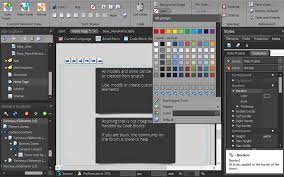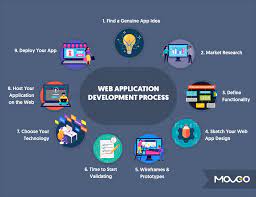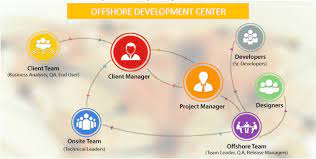In today’s digital age, web development has become an essential skill for businesses and individuals alike. Whether you’re a professional developer or a beginner looking to create your own website, having the right software can greatly enhance your productivity and efficiency. In this article, we will explore some of the best software options available for web development.
- Visual Studio Code: This free source code editor developed by Microsoft has gained immense popularity among web developers. It offers a wide range of features such as syntax highlighting, debugging capabilities, and extensions that allow you to customize the editor to suit your needs. With its user-friendly interface and extensive plugin ecosystem, Visual Studio Code is a favorite among developers across various platforms.
- Sublime Text: Known for its speed and simplicity, Sublime Text is another popular choice among web developers. It offers a distraction-free writing experience with powerful features like multiple cursors and split editing. Its intuitive interface and extensive customization options make it a reliable choice for developers who value simplicity without compromising functionality.
- Atom: Developed by GitHub, Atom is an open-source text editor that has gained widespread adoption in the web development community. It boasts a highly customizable interface and supports multiple programming languages out of the box. With its vast library of plugins and themes, Atom allows developers to tailor their workflow according to their preferences.
- Adobe Dreamweaver: As one of the pioneers in web development software, Adobe Dreamweaver continues to be a popular choice for both beginners and professionals alike. It offers a visual design interface alongside powerful coding capabilities, making it suitable for users with varying levels of expertise. With features like live preview and built-in FTP support, Dreamweaver simplifies the process of creating visually appealing websites.
- PhpStorm: Specifically designed for PHP development, PhpStorm is an integrated development environment (IDE) that provides advanced tools for coding, debugging, and testing PHP applications. With its intelligent code completion feature and seamless integration with popular frameworks, PhpStorm streamlines the development process and enhances productivity for PHP developers.
- Brackets: Developed by Adobe, Brackets is an open-source code editor that focuses on front-end web development. It offers a clean and minimalist interface with features like inline editing and live preview, making it ideal for working with HTML, CSS, and JavaScript. Additionally, Brackets supports extensions that further extend its functionality.
These are just a few examples of the best software options available for web development. Each one has its own unique features and strengths, so it’s important to choose the software that aligns with your specific needs and preferences. Ultimately, finding the right software can greatly enhance your web development workflow and help you create stunning websites efficiently and effectively.
7 Frequently Asked Questions about the Best Software for Web Development
- What is the best software for web development?
- Which software is recommended for beginners in web development?
- Is there any free software available for web development?
- What are the essential features to look for in web development software?
- Can you recommend a user-friendly software for both coding and designing websites?
- Which software is best suited for specific programming languages like PHP or JavaScript?
- Are there any industry-standard or widely-used software options for professional web developers?
What is the best software for web development?
The best software for web development can vary depending on individual preferences and specific project requirements. However, there are a few widely recognized software options that are highly regarded in the web development community. Here are some of the top choices:
- Visual Studio Code: This free source code editor developed by Microsoft has gained immense popularity due to its extensive features, including a wide range of extensions, debugging capabilities, and an intuitive user interface.
- Sublime Text: Known for its speed and simplicity, Sublime Text offers powerful features such as multiple cursors, split editing, and a distraction-free writing experience.
- Atom: Developed by GitHub, Atom is an open-source text editor that supports multiple programming languages and offers a highly customizable interface with a vast library of plugins and themes.
- Adobe Dreamweaver: As one of the pioneers in web development software, Dreamweaver provides both visual design capabilities and advanced coding features. It is suitable for users with varying levels of expertise.
- PhpStorm: Specifically designed for PHP development, PhpStorm is an integrated development environment (IDE) that offers advanced tools for coding, debugging, and testing PHP applications.
- Brackets: Developed by Adobe, Brackets is an open-source code editor that focuses on front-end web development with features like inline editing and live preview.
Remember that the “best” software ultimately depends on your personal preferences, project requirements, and the programming languages you work with. It’s always recommended to try out different options to find the software that suits your needs best.
Which software is recommended for beginners in web development?
For beginners in web development, it is recommended to start with software that is user-friendly, intuitive, and provides a gentle learning curve. Here are some software options that are well-suited for beginners:
- Visual Studio Code: Visual Studio Code (VS Code) is a popular choice among beginners due to its simplicity and extensive documentation. It offers a clean interface, easy installation process, and a wide range of extensions that can assist with coding and provide helpful features like auto-completion and syntax highlighting.
- Sublime Text: Sublime Text is known for its ease of use and beginner-friendly features. It provides a straightforward interface, quick setup process, and intuitive functionalities like multiple cursors for efficient editing. Additionally, Sublime Text has an active user community that offers plenty of resources for beginners.
- Atom: Atom is an open-source text editor that caters to the needs of both beginners and experienced developers. It offers a visually appealing interface, customizable themes, and an extensive library of plugins that can enhance the development experience for beginners.
- Brackets: Brackets is designed specifically for front-end web development and is highly recommended for beginners who want to focus on HTML, CSS, and JavaScript. It provides a clean interface with live preview functionality, making it easier to see changes in real-time as you code.
These software options provide beginner-friendly features while still offering enough flexibility to accommodate growth as your skills progress. Ultimately, the choice depends on personal preference, so it’s worth trying out different options to find the one that feels most comfortable for your learning journey in web development.
Is there any free software available for web development?
Absolutely! There are several free software options available for web development that provide powerful features and functionalities. Here are a few popular ones:
- Visual Studio Code: This widely used source code editor developed by Microsoft is completely free and offers a vast range of features, including syntax highlighting, debugging, version control integration, and an extensive library of extensions.
- Atom: Developed by GitHub, Atom is an open-source text editor that is highly customizable and supports multiple programming languages. It provides a user-friendly interface and offers features like smart autocompletion, file system browser, and a wide variety of plugins.
- Brackets: Brackets is another free open-source code editor created by Adobe. It focuses on front-end web development and offers features like live preview, inline editing, and preprocessor support. It also has an active community that continually develops extensions to enhance its functionality.
- Sublime Text (Free Evaluation Version): Although Sublime Text is not technically free, it offers an indefinite evaluation period without any enforced time limit or feature restrictions. This allows users to enjoy its powerful features such as multiple cursors, split editing, and a distraction-free interface for as long as they need.
- NetBeans: NetBeans is a free and open-source integrated development environment (IDE) that supports multiple programming languages including HTML, CSS, JavaScript, PHP, and more. It provides advanced coding assistance with features like code templates, refactoring tools, and version control integration.
These are just a few examples of the many free software options available for web development. Each one has its own unique set of features and advantages, so it’s worth exploring them to find the one that best suits your needs and preferences.
What are the essential features to look for in web development software?
When selecting web development software, there are several essential features to consider. These features can greatly impact your productivity, efficiency, and the overall quality of your web development projects. Here are some key features to look for:
- Code Editor: A robust code editor is a fundamental feature of any web development software. Look for an editor that offers syntax highlighting, auto-completion, code formatting, and the ability to handle multiple programming languages. It should also provide advanced editing capabilities like find and replace, code folding, and indentation control.
- Debugging Tools: Effective debugging tools are crucial for identifying and resolving errors in your code. Look for software that provides built-in debugging capabilities such as breakpoints, step-by-step execution, and variable inspection. This will help you track down issues and improve the overall quality of your code.
- Version Control Integration: Version control is essential for collaborative development or managing different versions of your project. Ensure that the software supports integration with popular version control systems like Git or SVN. This enables seamless collaboration with other developers and simplifies project management.
- Live Preview: A live preview feature allows you to see real-time changes in your website as you write code. It provides instant feedback on how your changes will look in a browser without having to constantly switch between windows or refresh the page manually.
- Framework Support: If you work with specific web frameworks like React, Angular, or Laravel, ensure that the software supports these frameworks out of the box or offers extensions/plugins for seamless integration. Framework-specific features can enhance productivity by providing shortcuts, templates, and automated tasks tailored to those frameworks.
- Responsive Design Tools: With the increasing importance of mobile-friendly websites, having responsive design tools is crucial. Look for software that offers features like media query support, viewport simulation, and device-specific testing options to ensure your websites look great across different screen sizes.
- Extensions/Plugins Ecosystem: A vibrant ecosystem of extensions or plugins can greatly extend the functionality of your web development software. Check if the software has an active community that develops and maintains useful extensions for additional features, such as linting, task automation, and code snippets.
- Performance Optimization: Efficient performance is vital for a successful website. Look for software that offers built-in tools or integrations for performance optimization, such as minification of CSS and JavaScript files, image compression, caching mechanisms, and code profiling.
- Cross-Browser Compatibility: Ensure that the software provides features or tools to test your website’s compatibility across different browsers. This can include browser preview options or integration with testing platforms to help you identify and fix any browser-specific issues.
- Community Support and Updates: Consider the availability of documentation, tutorials, forums, and active community support for the software you choose. Regular updates and bug fixes by the developers indicate a commitment to improving the software’s functionality and addressing user feedback.
By considering these essential features when selecting web development software, you can find a tool that aligns with your specific needs and enhances your productivity as a web developer.
Can you recommend a user-friendly software for both coding and designing websites?
Certainly! One software that stands out for its user-friendly approach to both coding and designing websites is Adobe Muse. Adobe Muse is a visual web design tool that allows users to create responsive websites without writing any code.
With its intuitive drag-and-drop interface, users can easily design and customize their websites by placing elements such as images, text, and buttons exactly where they want them. Adobe Muse provides a wide range of pre-designed widgets and templates, making it easy for beginners to get started.
For those with coding experience or who want more control over the design, Adobe Muse also offers the ability to add custom HTML, CSS, and JavaScript code. This flexibility allows users to further enhance their websites by incorporating advanced functionality or integrating third-party services.
Adobe Muse also provides built-in features for creating responsive designs, ensuring that your website looks great on all devices and screen sizes. It simplifies the process of designing multiple layouts for different screens without requiring extensive knowledge of responsive web design principles.
Additionally, Adobe Muse seamlessly integrates with other Adobe Creative Cloud applications such as Photoshop and Illustrator. This allows designers to easily import assets from these programs into their website projects, streamlining the design workflow.
Overall, Adobe Muse is an excellent choice for users who want a user-friendly software that combines both coding and designing capabilities. Its visual approach makes it accessible to beginners while still offering flexibility for more experienced users who want to dive into the code.
Which software is best suited for specific programming languages like PHP or JavaScript?
When it comes to specific programming languages like PHP or JavaScript, there are software options that are particularly well-suited for each language. Here are some recommendations:
For PHP development:
PhpStorm: This IDE (Integrated Development Environment) is specifically designed for PHP development. It offers advanced features like intelligent code completion, debugging tools, and seamless integration with popular frameworks like Laravel and Symfony.
Sublime Text: While not PHP-specific, Sublime Text is a highly customizable text editor that supports PHP syntax highlighting and offers powerful features like multiple cursors and split editing. It is a lightweight option that many PHP developers find efficient and enjoyable to use.
Visual Studio Code: Another versatile choice, Visual Studio Code has excellent support for PHP development through its extensive collection of extensions. It provides features like debugging capabilities, IntelliSense code completion, and integrated terminal access.
For JavaScript development:
Visual Studio Code: With its robust ecosystem of extensions and strong support for JavaScript, Visual Studio Code is a top choice for JavaScript developers. It offers features like IntelliSense, debugging tools, and integrated version control.
Atom: Atom is an open-source text editor known for its flexibility and extensive customization options. It has a strong community of developers who have created numerous packages tailored specifically for JavaScript development.
WebStorm: Developed by JetBrains, WebStorm is an IDE dedicated to web development that includes comprehensive support for JavaScript frameworks like Angular, React, and Vue.js. It provides intelligent coding assistance, built-in testing tools, and seamless integration with popular version control systems.
While these suggestions are well-regarded within the web development community for their compatibility with specific programming languages, it’s important to note that personal preference also plays a significant role in choosing the right software for your needs. Ultimately, the best software suited for PHP or JavaScript will depend on your individual workflow preferences and project requirements.
Are there any industry-standard or widely-used software options for professional web developers?
Absolutely! In the world of professional web development, there are a few industry-standard and widely-used software options that have become go-to choices for many developers. These tools are known for their robust features, extensive community support, and widespread adoption. Let’s explore some of them:
- Visual Studio Code: Developed by Microsoft, Visual Studio Code (VS Code) has gained immense popularity among professional web developers. It offers a wide range of features like intelligent code completion, debugging capabilities, Git integration, and an extensive marketplace for extensions. VS Code supports multiple programming languages and platforms, making it a versatile choice for developers.
- Sublime Text: Known for its speed and simplicity, Sublime Text remains a popular choice among professionals. It offers powerful features like multiple cursors, split editing, project management tools, and a vast collection of plugins to enhance productivity. Its stability and performance make it a reliable choice for many developers.
- JetBrains WebStorm: WebStorm is an integrated development environment (IDE) specifically designed for web development. Developed by JetBrains, it provides advanced coding assistance for HTML, CSS, JavaScript, and popular frameworks like Angular and React. With its intelligent code completion, refactoring tools, and built-in debugging capabilities, WebStorm is widely used by professional web developers.
- Adobe Dreamweaver: As one of the longest-standing web development software options in the industry, Adobe Dreamweaver continues to be favored by professionals worldwide. It offers a visual design interface alongside powerful coding capabilities with support for HTML5, CSS3, JavaScript, and more. Dreamweaver also integrates well with other Adobe Creative Cloud applications.
- Git: While not strictly considered software for web development per se, Git has become an industry-standard version control system widely used by professional developers. It allows teams to collaborate efficiently on projects while keeping track of changes made to files over time.
These are just a few examples of widely-used software options in the professional web development community. It’s important to note that preferences may vary among developers, and some may choose different tools based on their specific needs and workflows. However, these options have gained a strong reputation and are trusted by many professionals in the field.




